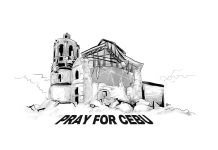
THE MAGNITUDE 6.9 earthquake that shook Cebu this week and rattled much of Western Visayas is a stern reminder of the risks we live with every day. Our region sits dangerously close to the West Panay Fault, the same geological line that triggered the deadly “Lady Caycay” earthquake of 1948. If history and science are any indication, it is not a matter of if another major quake will strike, but when.
The Office of Civil Defense’s (OCD) urgent order for a region-wide inspection of buildings and infrastructure is therefore prudent, and very essential. Schools filled with children, hospitals caring for the sick, bridges carrying thousands of commuters, and housing projects sheltering poor families — these are the structures that must never be allowed to fail. Yet in Western Visayas, many of these facilities are decades old, built long before modern seismic standards were enforced. Every crack, every leaning wall, every unstable foundation left unchecked is a potential death trap.
This region has seen enough of what weak infrastructure can do. The devastation of the “Lady Caycay” quake — which toppled church belfries in Jaro, San Joaquin, and Arevalo, split the earth open in Antique, and even caused a small tsunami — remains etched in memory. More recently, we have also witnessed how questions of construction quality can erode public confidence, as with flyovers and flood-control projects in Iloilo that have been dogged by concerns over workmanship. These experiences underscore why structural resilience cannot be treated as an afterthought.
Compliance with building codes is not optional. Retrofitting of older structures cannot be indefinitely postponed. Inspections must not be reduced to box-ticking exercises. The lives of our children, our patients, our commuters, and our workers hang in the balance. If a school collapses during class hours, or a hospital buckles under tremors, the cost will be counted not only in pesos but in irreplaceable lives.
This is why vigilance must extend beyond government directives. Local governments, engineers, building owners, and ordinary citizens all share responsibility. Residents should not ignore the small cracks in their homes or offices. Local officials must ensure inspection reports translate into action, not just paperwork. And public pressure must remain unrelenting — because safety lapses in infrastructure often happen in the shadows of complacency.
The earthquake in Cebu was a warning tremor for Western Visayas. We cannot gamble with lives by tolerating unsafe buildings. We must invest in resilience today — in inspections, retrofitting, and strict code enforcement — so that when the earth shakes again, as it surely will, our communities will still be standing.







